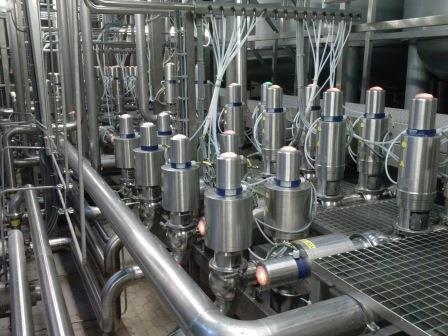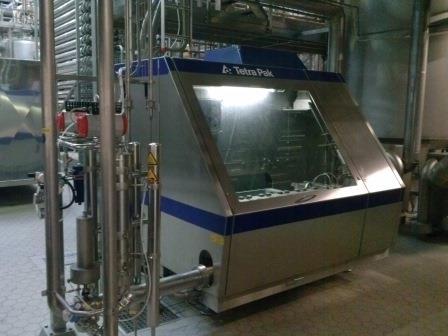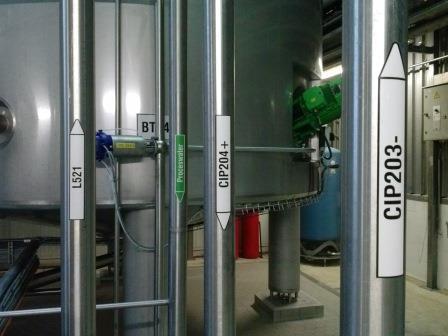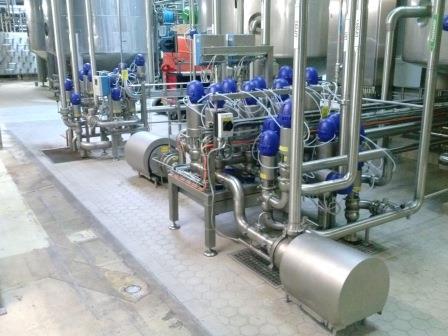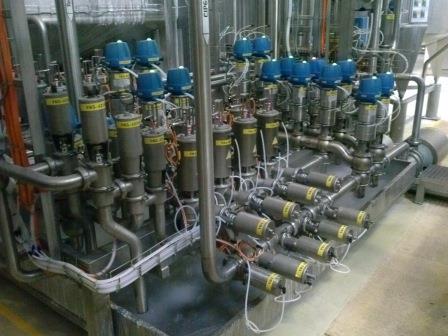Process engineering involves translating the needs of the customer into (typically) production facilities that convert "raw materials" into value-added components that are transported to the next stage of the supply chain, typically "packaging engineering".
Prior to construction, the design work of process engineering begins with a "block diagram" showing raw materials and the transformations/unit operations desired. The design work then progresses to a process flow diagram where material flow paths, storage equipment (such as tanks and silos), transformations/Unit Operations (such as pasteurisation, mixing, separations, sterilization, etc.) and e.g. flowrates are specified. Additionally a list of all pipes are defined together with their contents and material properties such as density, viscosity, particle size distribution, flow rates, pressures, temperatures and specific materials of construction for the piping and unit operations.
The process flow diagram is then used to develop a process and instrumentation diagram (P&ID) which includes sizing information to address the desired flowrates, process controls (such as tank level indications, material flow meters, weighing devices, motor speed controls, temperature and pressure indicators/ controllers, etc.). The P&ID is then used as a basis of design for developing the "functional design specification" which outlines the operation of the process. From the "P&ID", a proposed layout (general arrangement) and other engineering disciplines are involved such as civil engineers, IT, , etc.). Prior to finalize the design an HAZOP study is advisable. In this phase the design will be challenged against process safety point of view.
All previous work is directed toward defining the scope of the project, then developing a cost estimate to get the design installed, and a schedule to communicate the timing needs for engineering, procurement, fabrication, installation, commissioning, startup, and ongoing production of the process. Depending on the needed accuracy of the cost estimate and schedule that is required, several iterations of designs are defined and generally provided to customers or stakeholders. The process engineer incorporates their feedback, additional requirements and wants (scope revisions) into the overall design and additional cost estimates and schedules are developed for funding approval. For larger projects a Value Engineering is advisable. This is concept review by a multidisciplinary team (teammembers + non project related people) and the purpose is to challenge the concept to see if the current concept is the best value for money.
Projects are validated according the V-model:
If the business case is approved, and project is going on, their is first a Design Qualification (DQ) phase to do a final review of the concept before ordering all the equipment. This is done in a multidisciplinary team to see if the final concept is the best design that is feasible taken all the different restraints in account.
In the construction phase and commissioning phase (implementation), other validation steps are executed. After construction phase and before activating the utilities at the installation, an Installation Qualification (IQ) is done. This is a check of the installation if everything is placed as agreed at the P&ID during DQ phase. Together with the software FAT (Factory Acceptance Test), the project can go on to the commissioning phase. The closure of the commissioning phase by the startup team is formalized in the OQ (Operational Qualification). In this validation step the installation performance is checked against the technical requirements from the URS or FDS. E.g. flow rates, mixing times, sterility tests,... are checked in the OQ phase. After this phase the installation is handed over to production and released for commercial production. This is called the Performance Qualification (PQ) phase and the goal of this phase is to test the installation under 'real' circumstances that cannot be tested during the OQ phase. These requirements are defined in the URS that is agreed in the beginning of the project. E.g. maximum run times, different batches after each other, ... . This period takes mostly a few months to validate the installation against production circumstances. After the PQ phase the installation is approved and the project can go to the project closure and evaluation report.
An important matter in designing installations is Process Safety and Machine Safety.
- Process safety means that no hazardous situation can occur when operating the installation, in normal situation nor in situation with failures. To verify the process safety, the design is challenged and verified with a Hazop study. Often (small) adaptions are initiated from an Hazop study.
- Machine safety has everything todo with CE. Depending on the installation and place where the installation will be placed, several Directives and Guidelines are applicable. This can be e.g. the overall machine directive 2006/42/EG or Low Voltage directive 2006/95/EG. Together with the directives, the constructor is also obligated to foresee a risk analysis at the machine, to foresee manuals in the language of the user, to make a construction file,...
A brief overview of the latest projects with Project Management - Process Engineering and Automation:
- New Fristi Mixing Line (FrieslandCampina ): 5 mixingtanks 100m³, a loop system to mix powders and liquids with an Almix system in batch or inline method
- New Indirect Sterilizer 30m³/h (FrieslandCampina)
- New Aseptic Tank 70m³ (FrieslandCampina)
- New CIP unit: 6 cip lines with different capacities (FrieslandCampina)
- High capacity reception lines (FrieslandCampina)
- High accuracy dosing system for Coffee Milk (FrieslandCampina)
- Water Treatment installation (FrieslandCampina)
- ...
DNE has experience for more then 10 years in process engineering. Don't hesitate to contact me.

